While looking for a bellows on EBay I came across this strange Heath Robinson like contraption that had me both puzzled and fascinated. On closer inspection, it looked like two bellows had ingeniously been fitted together to form one huge unit! There also appeared to be a third miniature-like bellows attached to the end of the second unit. To top it all, the entire apparatus came with a reversed SMC Takumar 1.2/55mm lens. All this for £40! It looked to good to be true. The only drawback was that the collection point was in Birmingham and I live in South Wales.

Strange looking bellows apparatus as depicted on EBay
Classic Pentax bellows of the 1960s/70s were classy and wonderfully engineered units and worth many times more than the asking price (even including petrol expenses). The temptation was therefore too irresistible and so I rang the seller to try and glean some information regarding condition and provenance. Apparently, an enthusiast had put the bellows together but the seller had no idea of the current value of the bellows and thought he was selling one unit and not the two! I remembered George Orwell’s famous statement, ‘ignorance is bliss’ as the seller’s lack of photographic knowledge would indeed result in my favour. I drove to Birmingham feeling both excited and apprehensive, as all I had to base my judgements on was the photographic evidence alone.
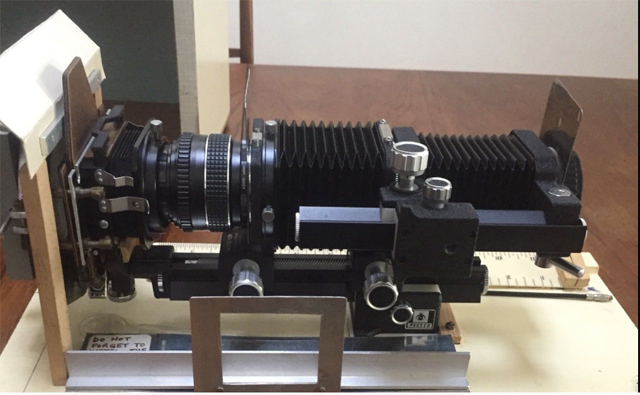
Turning the apparatus around one can see more clearly how the smaller bellows unit is turned side-ways and joined to the end of the larger bellows. The control knobs at the bottom move the larger bellows and the knobs at the top control the smaller bellows. Having both units attached together would have given incredible magnification, ideal for blowing up slides or better still extreme macro!
On seeing the bellows, I new straightaway that I had found a bargain! A wooden box contained the bellows and everything appeared in excellent condition. Arriving home, the first thing I did was to further inspect the apparatus while taking the units apart. I was pleased to find that the bellows were indeed the excellent Pentax-M series. This bellows set is an old fashioned piece of apparatus that most of the major brands don’t even make anymore: a manual piece of photo kit that allows a lens to move closer and further away from the sensor, which decreases and increases the magnification that the lens will eventually render. A longer, stretched out bellows gives you greater magnification, whereas a compressed bellows gives less magnification.
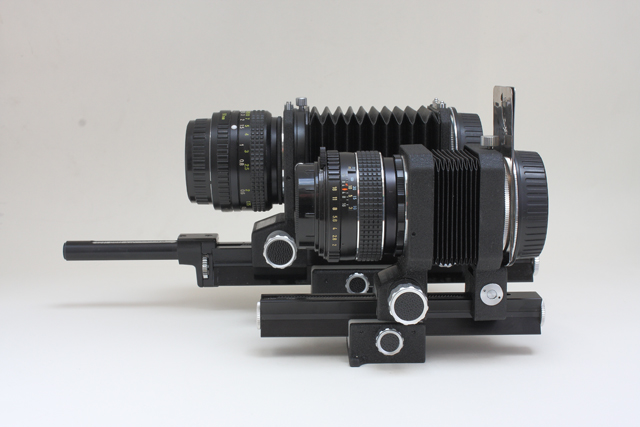
This is what I had after taking the two bellows apart. The larger bellows in the background is a Pentax Auto Bellows and the smaller one in the foreground is the Asahi Pentax Bellows II (both manufactured in the early 1970s). The Pentax Bellows II also came with a SMC Pentax-M 40mm lens. For the Pentax Auto Bellows, I attached a reversed Ricoh 50mm 1.4 lens (my first lens dating back to 1980).
Pentax-M series bellows, are old 1970s pieces of equipment that are beautifully crafted and still give excellent performance almost 50 years later. The removable bellow is worthy of note, as it means you can add a lens such as a Raynox very easily. They don’t make things like this as well as they used to.
 Pentax Auto Bellows: The right-hand-side knob locks the front of the bellows while the left-hand knob locks the rear of the bellows. On the other side (see next pic) the knobs are larger for moving the bellows backwards and forwards. The central knob moves the whole assembly. It’s good to have as much of this adjustability as possible as it allows you to get set up nicely in terms of working distance.
Pentax Auto Bellows: The right-hand-side knob locks the front of the bellows while the left-hand knob locks the rear of the bellows. On the other side (see next pic) the knobs are larger for moving the bellows backwards and forwards. The central knob moves the whole assembly. It’s good to have as much of this adjustability as possible as it allows you to get set up nicely in terms of working distance.
Like the best bellows that you can buy for macro the Pentax-M has at least 3 adjustable plains of movement on the knobs: one in which the front ring/adaptor (on which the lens sits) can be moved backwards and forwards, another the back ring/adaptor (on which the camera end sits) can be moved backwards and forwards and the whole mechanism (i.e. the rail both the front and back rings sit) can also independently be moved backwards and forwards.
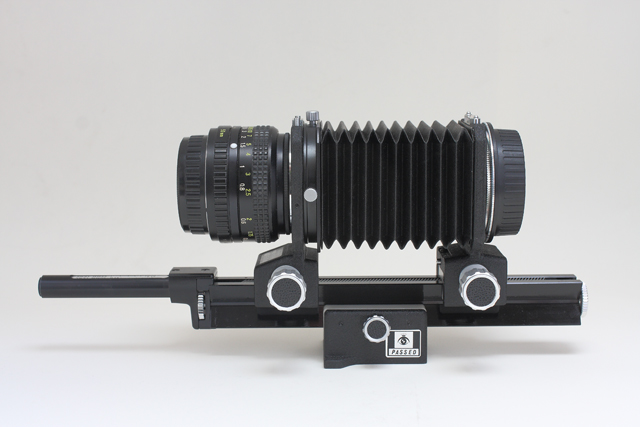
Pentax Auto Bellows: From this side the knobs are larger for moving the bellows on both the front and rear plane. The small knob in the centre is for locking the assembly on the rail.
It’s good to have as much of this adjustability as possible as it allows you to get set up nicely in terms of working distance, and set up nicely in terms of tweaking the magnification. Notice that the smaller Pentax bellows only allows movement in the rear connector (nearest the camera). This smaller and lighter unit may not be as solid and accurate for studio work but is nevertheless ideal for the field.
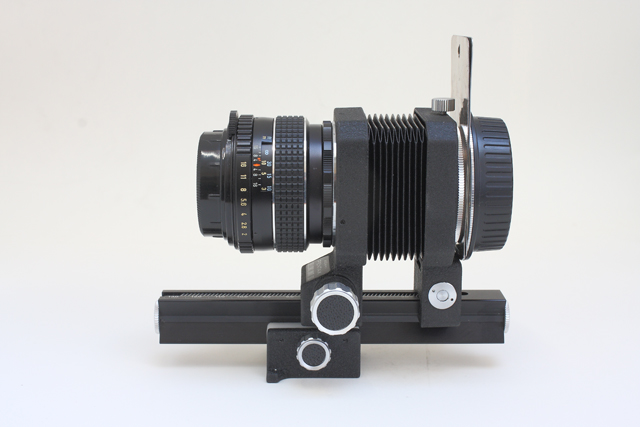
Asahi Pentax Bellows II: The large knob moves the front of the bellows. The small central knob locks the assembly on the rail. Note that in order to fit the bellows to Canon camera adapter I had to sandwich a thin piece of aluminium between the bellows and adapter.
Beyond having the three way adjustment on the bellows, the next nice things to have is a very smooth backwards and forward movement adjustment, and the ability to lock position with a second tightening nut on each of the axis that can move.

Asahi Pentax Bellows II: The central knob is for locking the assembly on the rail. The rear (camera) mounting board does not have nylon bearings, but is movable and locked by a lever. All movements operate smoothly and are precise.
There are some other interesting things about the Pentax-M bellows. They’re not exactly deal breakers but their nevertheless highly desirable things to have, such as a removable rear adapter that unscrews with a little bolt – it makes for a nice convenience when getting set up. A reversible mount is also a nice luxury – rather than having a brand-specific end, just turn it round and you have M42.
One thing that you do need to bear in mind that by buying an old set of bellows from the 1970s such as the Pentax-M bellows, you’re buying a piece of equipment that’s almost 50 years old so it may not be terribly surprising if it’s seen better days. For example the accordion on old bellows is made of paper and the folds can and do wear out because of their age. I was lucky in that the accordion on both bellows appeared to be in excellent condition with little signs of wear. The rack and gears on the larger Auto Bellows unit were rather stiff and benefitted from a little bit of sewing machine oil.
The tiny bellows that had me perplexed turned out to be a slide-copier, so that reproductions of slides and film could be made.
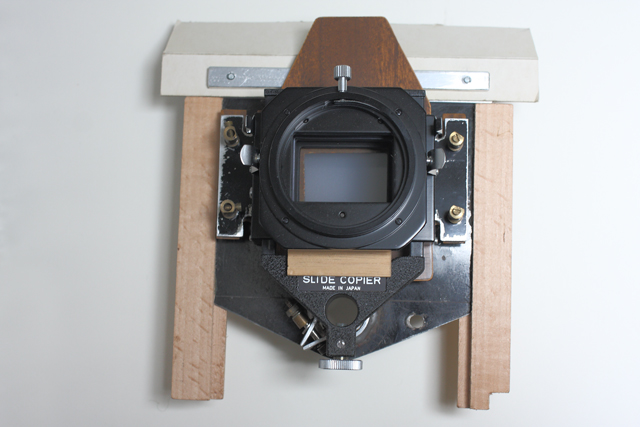
This had me perplexed but it turns out to be a slide copier from the good old days of film.
I’m looking forward to using these bellows and seeing how they compare to my Canon MP-E 65mm lens. However, that’s a subject for a future post. For the time being here is some more detailed information taken from the official Pentax Bellows Manual which can be downloaded from the excellent extreme-macro.co.uk site.
Asahi Pentax Auto Bellows or “Honeywell Pentax Auto Bellows Unit”.
The larger of the two bellows, this bellows unit is robust and versatile, highly flexible, well designed and built. It came with the Pentax Slide Copier attachment.

This auto bellows unit utilizes a strong, well-engineered single “X” rail. It also incorporates a geared tripod-mounting block that can be positioned along the bottom of the X rail to properly balance your camera/bellows/lens combination. The operation of the bellows unit is smooth, with the front lens board, rear camera board, and movable tripod seat gear operated with micro-action control knobs. It uses nylon blocks as bearing surfaces. All three-movement operations are precise, allow no creep, and have a locking knob on the opposite side to the control knobs.
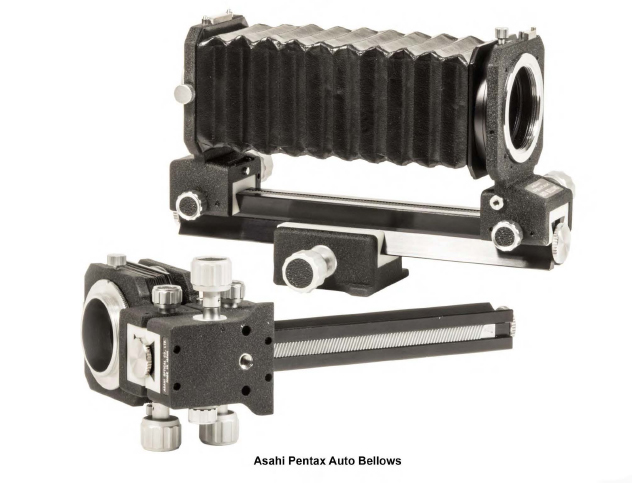
The Camera Body Connector Ring is removable from the bellows, and doing so is the easiest way to mount the camera body. K mount camera bodies require a Pentax Mount Adaptor K. The camera mount can be rotated, within the rear board allowing the camera body to be changed to vertical orientation. With modern digital bodies the bulkier body will not allow this unless a short extension tube is used to position the body further out to clear the rear board.
Leaving a short, non-auto, extension tube fitted with a Pentax Mount Adaptor K on the bellows gives you the advantage of a semi-permanent K mount conversion and avoids the finicky task of removing the adaptor from the body every time the bellows is removed.
The robust bellows can easily handle the extra weight and longer length of lenses up to 300mm
Asahi Pentax Bellows II (Late production):
This is a scaled down, economical, version of the excellent Asahi Pentax Auto Bellows but with fewer features. It does not support automatic diaphragm operation, but is still an excellent piece of macro field equipment. It is well designed and built, compact, light, strong, with nylon (bearing) blocks on moving parts, and is simple to use. The rear (camera) mounting board does not have nylon bearings, but is movable and locked by a lever. All movements operate smoothly and are precise.
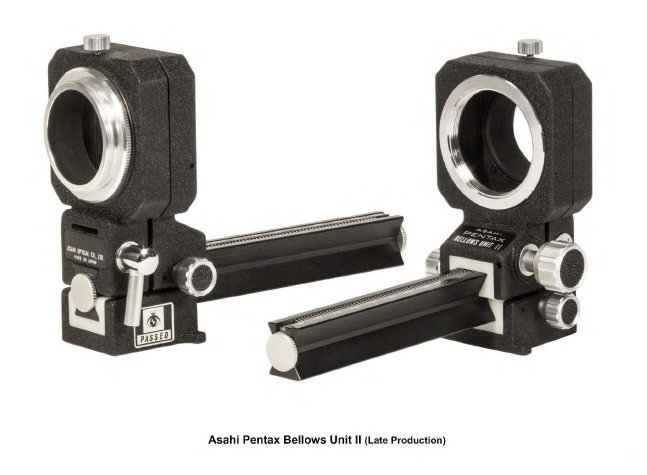
This bellows unit utilizes the same single, strong “X” rail design as the Asahi Pentax Auto Bellows unit and similarly incorporates a tripod mounting block that can be positioned along the bottom of the x rail to properly balance your camera/bellows/lens combination. This mounting block is not geared, as the Auto Bellows is, but the friction of the nylon bearings provides a smooth and easily adjustable placement along the bottom of the focusing rail, the rear board does not have a nylon bearing block, nor is geared, but is moveable.
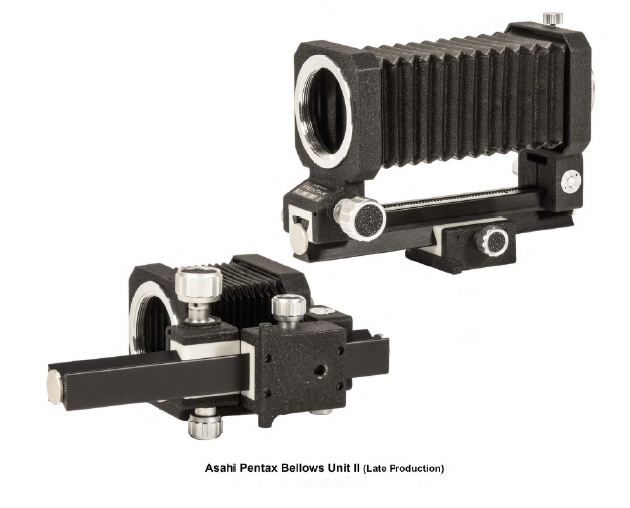 The Camera Body Connector Ring (bellows to camera) is removable and doing so is the easiest way to mount the camera body. K mount camera bodies require a Pentax Mount Adaptor K. The camera mount can be rotated, within the rear board allowing the camera body to be changed to vertical orientation, however the prism and grip protrusion of new digital bodies will not allow this unless a short extension tube is used to position the body further out to clear the rear board.
The Camera Body Connector Ring (bellows to camera) is removable and doing so is the easiest way to mount the camera body. K mount camera bodies require a Pentax Mount Adaptor K. The camera mount can be rotated, within the rear board allowing the camera body to be changed to vertical orientation, however the prism and grip protrusion of new digital bodies will not allow this unless a short extension tube is used to position the body further out to clear the rear board.
Leaving a short, non-auto, extension tube fitted with a Pentax Mount Adaptor K on the bellows gives you the advantage of a semi-permanent K mount conversion and avoids the finicky task of removing the adaptor from the body every time you are finished using the bellows.
The single X rail is marked in single millimetre increments to 135mm. This bellows can easily handle the extra weight and longer length lenses up to 150mm or even 200mm.

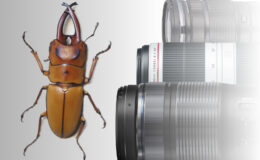
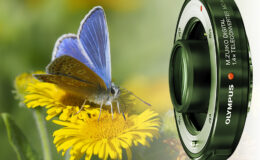



Leave a Comment